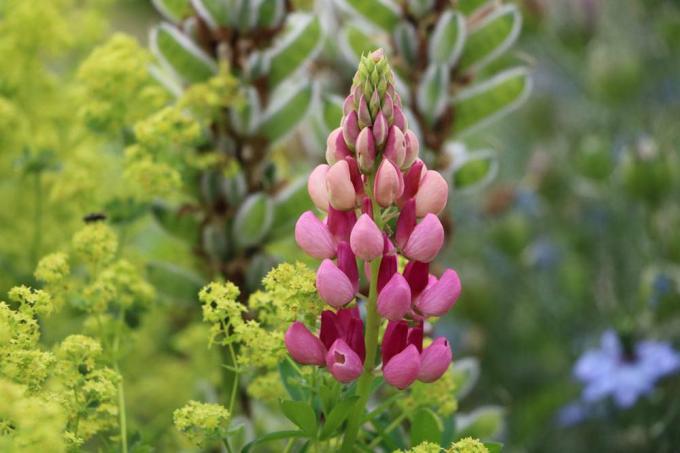
table of contents
- Lupins feel at home here
- Sunny location
- No wind
- Lean soil
- Permeable, loose soil structure
- Low pH
- No lime
- frequently asked Questions
Lupinus polyphyllus, as the garden lupine is scientifically correct, is striking because of its brightly colored, large flower candles. Lupins need a suitable location so that you can admire this splendor extensively.
In a nutshell
- as sunny as possible
- in partially shaded places at least three hours of sun a day
- There is little wind in the garden, otherwise the high stalks will bend over easily
- Leave enough space between the plants, air must be able to circulate
- lean, loose soil with a slightly acidic pH value
Lupins feel at home here
As with all perennials, you can of course also change the location of garden lupins. This is particularly recommended if the previous lupine location is not ideal or you want to share specimens that have become too large. The best time for such a project is early autumn. However, it is better to ensure the best possible growing conditions from the outset. The following six criteria will help you to find the right place in the garden.

Sunny location
The ideal lupine location is as sunny as possible - the more sun shines down on the perennial, the more beautiful and lush it will bloom. Basically, the plants also thrive in partial shade, but then need at least three hours of full sun a day. Otherwise, they will remain significantly smaller than normal and only produce few or even no flowers.
No wind
Under optimal conditions, garden lupins can grow to heights of between 80 and 120 centimeters, whereby the flower candles alone can be up to 50 centimeters long. These long shoots are not particularly wind-stable, which is why you should choose a sheltered, windless location for the perennials. If it is too windy, the stalks quickly bend or break. grow crooked. If such a lupine location is not available in the garden, the long shoots can be stabilized with a flower support or a perennial holder.
Tip: Nevertheless, lupins should not be too close together; you should leave a space of around 50 centimeters between the individual plants. This allows the air to circulate, which counteracts infection with fungal diseases such as powdery mildew.
Lean soil
Garden lupins are the right choice for poor, sandy soils: the plants accumulate plenty of nitrogen in their roots, which is why they are also popular for one Green manure - they can be used to replenish nutrient-poor soil in a natural way. Conversely, however, the perennials do not need a nutrient-rich subsoil. After all, you are self-sufficient.

Permeable, loose soil structure
The legumes are also sensitive to heavy soils and the resulting waterlogging, although their strong roots can basically penetrate solid soil. The soil must not be too wet, this inevitably leads to the death of the plant. A sandy, loose and well-drained subsoil is best suited as a lupine site anyway - this is where the plants feel most comfortable and bloom particularly beautifully.
Tip: A loamy, poorly drained soil can, however, be improved with plenty of sand. Dig a large planting hole, fill a several centimeter thick layer of sand on the bottom and mix the excavated material with sand as well. You can then plant the lupins.
Low pH
Garden lupins love a slightly acidic pH value, which is between 5.5 and 6.5 if possible. You can easily check the pH of your garden soil with a simple strip test from the pharmacy or pharmacy. check the hardware store. If it is too high, mix the excavated plant hole with a little rhododendron soil or deciduous humus.
No lime
Like so many plants that need acidic soil, garden lupins can only tolerate a small amount of lime. Therefore, only a soil with little or no lime should be selected as the lupine site. In addition, only soft rainwater or Use well stale and filtered tap water - otherwise the lime it contains will accumulate in the soil and gradually raise its pH value.

frequently asked Questions
If you choose a sufficiently large and stable planter - it should be deep rather than wide and, if possible, made of heavy Material such as clay - ornamental lupins can also be used very well as potted plants on the balcony or terrace cultivate. If you prefer varieties that remain as low as possible, they are easier to hold in the bucket and do not bend over so quickly. The perennials also need a sunny location in pots.
The pretty ornamental lupins are perennial shrubs that sprout anew every spring and will delight you with their eye-catching flower candles for many years to come. The plants are hardy and robust, only the last year's shoots should be cut back in spring. Pot flupins also need winter protection, for example by wrapping the planter with a fleece or something similar.
Lupins bloom between May and June, after which the fertilized flowers develop into dark, seed-containing pods. If you cut back the faded stems before fruit formation, the plants will develop a late second flowering pile by August. On the other hand, if you let the faded stand, the perennials will reliably seed themselves.
Usually for the garden or Ornamental lupins offered in the pot should not be eaten as they are poisonous due to the bitter substances they contain (alkaloids such as lupinine and sparteine). Eating just a single seed pod can cause symptoms of poisoning such as palpitations, nausea, vomiting, diarrhea and dizziness. If you want to grow the plants for consumption, you should use the non-toxic sweet lupins. Their seeds are very rich in protein.



